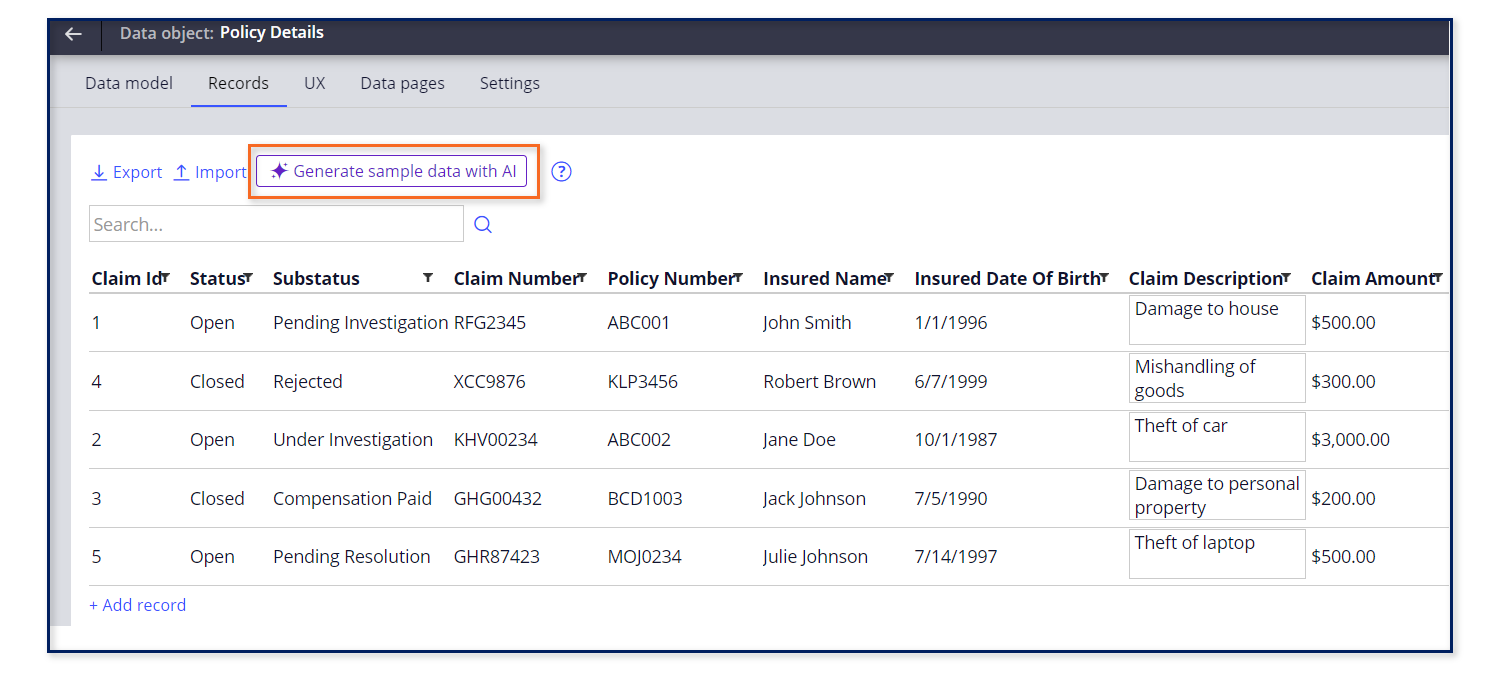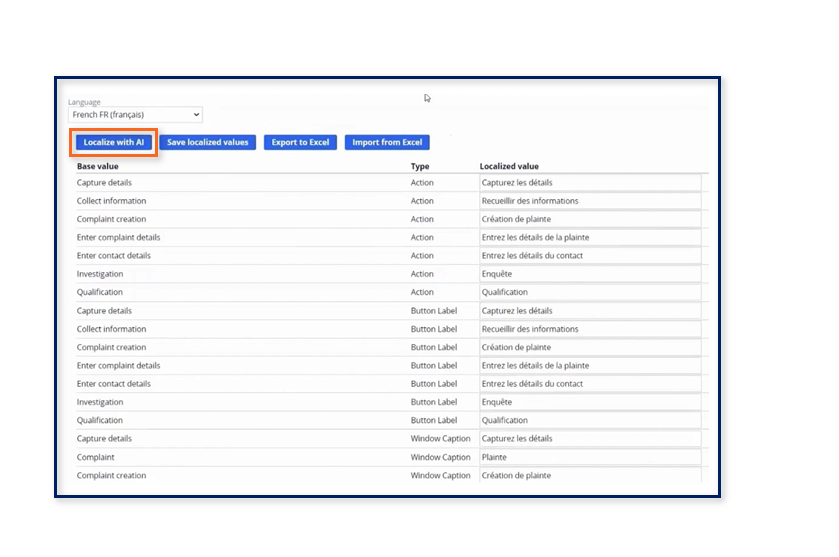9 ways that Pega developers can leverage Pega GenAI in Pega Infinity ’23 to build workflow applications faster
We’ve all heard it a million times: Generative AI will dramatically transform how developers work. From offloading the end-to-end development of simple modules, providing contextual developer guidance, documenting applications, generating tests, and more, these tools can and already help to accelerate our development workflows.
Pega is on a mission to double developer productivity and generative AI will play a massive role in making that possible. At PegaWorld 2023, we introduced Pega GenAI™, which brings over 20 new generative AI-powered features across customer service, customer engagement, workflow automation, and of course, low-code development.
Pega Infinity™ ’23 scratches the surface of what’s possible with low code and generative AI. New AI-powered dev assistance, coaching, and guidance features are infused across Pega Platform™ to help developers increase their productivity and effectiveness and to provide a platform where anyone can participate in adapting to change.
And, if you haven’t checked them out yet, there are over 80 PegaWorld sessions that you can replay RIGHT NOW, which cover everything from AI to automation to business outcomes to roadmap and more.
But how can Pega GenAI help Pega developers be more effective right now?
Here are a few pragmatic ways in which Pega developers can apply new Pega GenAI-powered low-code capabilities in Pega Infinity ’23 to build faster and better collaborate with their business partners.
Accelerating collaborative business and IT workflow design thinking
In a traditional software development project, planning and design can take weeks. It often requires business and IT stakeholders to pass lengthy requirements documents back and forth, which then require translation into actual code and low-code platforms.
Pega App Studio changes this paradigm. Pega helps business and IT to come together in a single, intuitive interface to turn planning and design thinking directly into working applications. App Studio gives devs the ability to configure the key components of a workflow application. Case Types, Personas, UX, Channels, data objects, and even components that require advanced configuration can be created in App Studio during design thinking sessions or by business users for pro devs to then dive into Dev Studio to complete.
But even in Pega, where business and IT can collaborate directly in the platform, getting started can be the hardest part.
Pega GenAI in Pega Infinity ’23 makes it so business and IT teams don’t have to start from scratch when starting a new project.
Developers can harness the breadth of industry knowledge baked into large language models (LLM), such as OpenAI’s GPT-4, to give teams something to react to and change.
So, in Pega Infinity ’23, when starting a new project, rather than looking at a blank canvas –, developers can sit down with their business partners to:
- Define the Stages and Steps of a workflow.
When creating a new Case Type in App Studio, click Use AI to suggest a life cycle and data model.
Based on the name of the Case Type and application you’re building, Pega GenAI makes an LLM call to ask for potential Stages and Steps. These LLMs have massive training datasets, which can produce a credible set of Stages and Steps for almost any workflow you can edit on the fly with your business partners.

- Define the Data Model for your workflow.
Similarly, in the New Case Type wizard, Pega GenAI makes an LLM call to ask for potential fields that you need to capture, manage, and calculate to drive this Case Type to done, including field types (for example, integer and Boolean) and Primary Fields (which the system automatically feeds into downstream UX development).
Be aware that sometimes Pega GenAI will suggest fields that overlap with the out-of-the-box case management properties of Pega Platform, such as create date, assigned to, resolved date, and more. It might also suggest fields that exist in your built-on layers. Take a moment to review this screen and define what you want to keep.
- Define the data objects.
In App Studio, data objects represent and virtualize external and stored non-workflow data, which workflows need to access and update across their lifecycles. Similar to how Pega GenAI taps into the industry knowledge of LLMs to suggest an initial workflow structure, it does the same for data objects. As a result, business and IT can quickly refine the set of data that they want to access and store, so pro devs have a better sense of what back-end systems should integrate with Pega.
To get a suggested data object structure, when creating a new data object in App Studio, click Use AI to suggest a life cycle and data model.
Pega GenAI will make an LLM call to ask for potential fields that you need to capture and manage as part of this object (again, including what field types and which fields should be Primary).
Again, make edits on the fly that save to the Case Type. Developers then have a solid foundation on which to build out comprehensive integrations to their back-end systems using the live data capabilities of Pega.
Effective business and IT collaboration early on is critical to the success of new application development.. and leveraging Pega GenAI in these three ways when starting a new project will help accelerate deeper discussions and streamline design thinking, leading to more successful outcomes faster.
Boosting productivity across daily development tasks
So Pega GenAI can help foster more effective business and IT collaboration in the design phase of a workflow — but what about day-to-day? How can developers take advantage of new capabilities to accelerate and simplify their day-to-day development and maintenance tasks?
In Pega Infinity ’23, developers can benefit from a few new GenAI-powered productivity boosters across Ruleforms and development activities, which helps automate manually intensive, straightforward tasks that developers take on every day. GenAI can help developers:
- Quickly map integrations to back-end systems.
Building integrations between systems can be the long pole in application development processes. And as APIs evolve, maintaining them can be just as time-consuming.
In Pega Infinity ’23, Pega GenAI can help simplify the integration process for developers — leveraging generative AI automatically.
In Pega App Studio, as you go through connecting data objects to back-end systems, there is a new map with AI option that applies an LLM to automatically pick up on the probable field relationships between Pega and the external back-end system (for example, identifying that Cust_ID in your back-end CRM should probably tie to a CustomerID field in Pega).

Developers can validate and edit mappings at any time.
- Customize the user experience by creating and sharing new UX components.
In applications that use the Pega Constellation UX architecture, low-code developers can quickly configure UX for customers and employees by leveraging an extensible library of React components. Pega has 100+ components built-in, but business owners often have custom requirements for how information is shown or captured in their applications, which require custom components. To deliver on these use cases, developers can build their own custom React components and share them with every developer in their organization through the Constellation library.
Traditionally, developers need to develop the React code through an integrated development environment (IDE) in their local environment. In Pega Infinity ’23, with GenAI, developers can jumpstart the creation of new Constellation components by using natural language, which dramatically accelerates the process and democratizes it to developers who are less familiar with the ins and outs of React and front-end development.
- Deliver a compelling user experience with real-time Insights and dashboards.
Insights and explore data help employees and managers to analyze real-time workflow data on the fly, enabling them to build and share data visualizations that give insight into key business and team performance KPIs.
Developers can also develop and embed Insights and dashboards in user experiences, which gives users a more compelling experience when they open an application for the first time.

Now, with Pega GenAI, developers and users who generate those Insights take seconds using natural language prompts. A new, Pega GenAI-powered prompt bar on the Explore data tab in App Studio and Pega applications gives developers and users the ability to ask questions and give prompts detailing the data visualization they want to build. And Pega GenAI applies an LLM to translate that request into a chart type, data type, measures, and filters.

After saving, you can expose these Insights to application users through dashboards, landing pages, and Case Views.
Quickly translating, testing, demoing applications and workflows
After you build out workflows and applications, how do you test them? How do you showcase them to business stakeholders? Traditionally, many development teams create custom components and automations that generate dummy data or test data for their QA teams or for internal demos, which can be a tedious exercise.
In Pega Infinity ’23, Pega GenAI simplifies testing and demos, so developers can access big test Data Sets and demo data for their applications instantly. GenAI can help developers with:
- Instantly populate data objects with sample Data Sets.
Demoing an application without data can be boring, and makes it difficult to test out different real-life scenarios. Pega GenAI in Pega Infinity ’23 helps developers quickly generate sample data to bring demos and testing to life.
On the Records tab in a data object, developers can use a new Generate sample data with AI option to populate objects with 10s or 100s of records, which makes both testing and demos more realistic and supports Cases and UX with data.

- Run through case forms with sample data.
Every developer or tester has run up against this: you’re testing out new forms and spending time entering semi-realistic data that will pass validation (for example, email, address, and so on).
Pega GenAI helps with this as well. A new Form fill with AI option on Case forms in design time environments populates fields with realistic data, which will likely pass validation, so developers and testers can quickly run through workflow scenarios.

In addition to testing, enabling users to engage with workflows in their language is critical to an accessible experience and supporting global operations. Traditionally, translating localized applications requires multiple weeks where developers export localized fields, send them to language SMEs or contractors, receive back translations, and get them back into the system. However, LLMs are trained across languages and can effectively translate from one language to another.
-
Jumpstarting application translation.
Pega GenAI in Pega Infinity ’23 helps accelerate localization by jumpstarting translations. In Pega Infinity ’23, a new Localize with AI button in the Localization wizard in Dev Studio calls Pega GenAI to take a first pass at translation into the language of your choice. You can then export the translation and send it to an SME for quicker validation rather than starting from scratch.
It’s an exciting time to be a Pega developer
Pega GenAI represents a massive opportunity for developers to increase their productivity, innovation, effectiveness, and collaboration with the business. And this is just the beginning.
And there’s so much more in store for developers beyond GenAI. Check out what’s new in the Pega Platform to learn about all the new low-code innovations across Pega.

